Question
Complete the emergency room scheduler application as described, must be completed in python. Patient details are entered in by the user, they are NOT provided
Complete the emergency room scheduler application as described, must be completed in python. Patient details are entered in by the user, they are NOT provided for this program. The program does not need it to work, the user enters in the details as they run the program. All .py files have been provided, please let me know if the following instructions are not clear. Thank you.
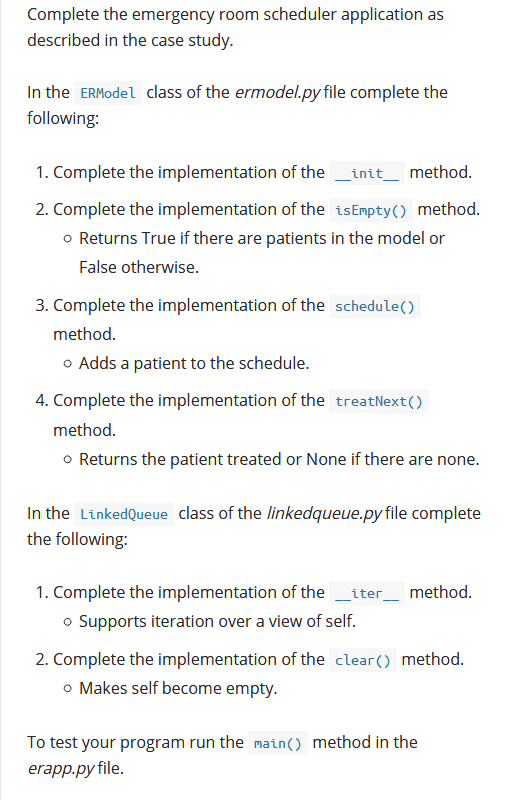
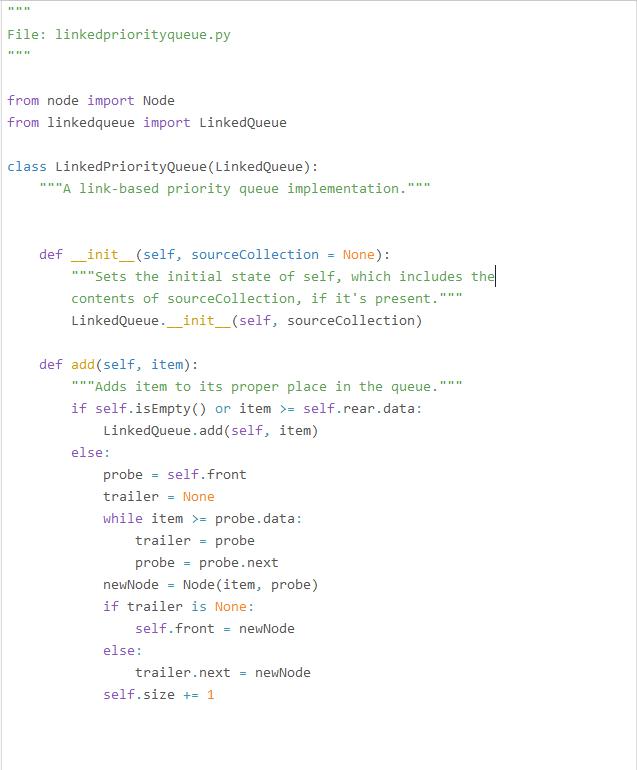
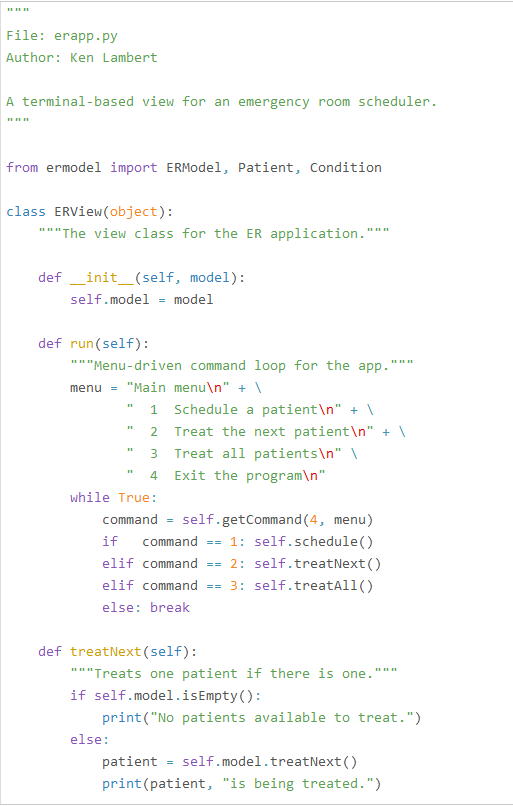
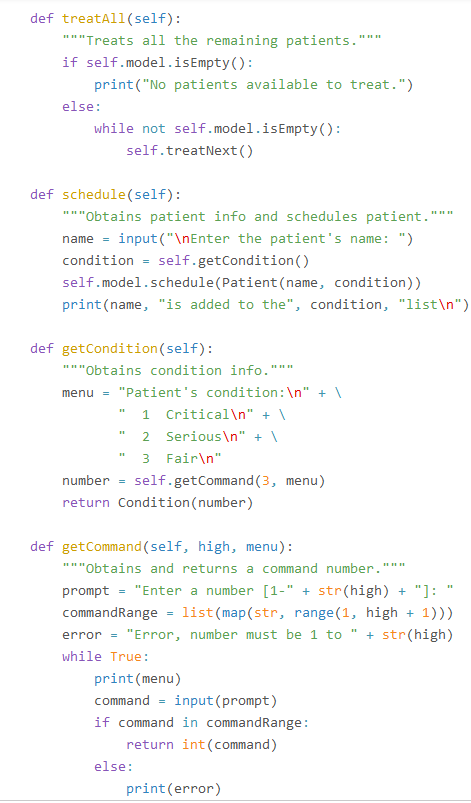
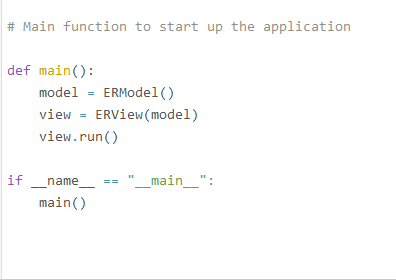
"""
File: linkedqueue.py
Author: Ken Lambert
"""
from node import Node
from abstractcollection import AbstractCollection
class LinkedQueue(AbstractCollection):
"""A link-based queue implementation."""
# Constructor
def __init__(self, sourceCollection = None):
"""Sets the initial state of self, which includes the
contents of sourceCollection, if it's present."""
self.front = self.rear = None
AbstractCollection.__init__(self, sourceCollection)
# Accessor methods
def __iter__(self):
"""Supports iteration over a view of self.
Visits items from bottom to top of stack."""
def visitNodes(node):
"""Adds items to tempList from tail to head."""
if not node is None:
visitNodes(node.next)
tempList.append(node.data)
def peek(self):
"""
Returns the item at the front of the queue.
Precondition: the queue is not empty.
Raises: KeyError if the stack is empty."""
if self.isEmpty():
raise KeyError("The queue is empty.")
return self.front.data
# Mutator methods
def clear(self):
self.size = 0
self.items = None
def add(self, item):
"""Adds item to the rear of the queue."""
newNode = Node(item, None)
if self.isEmpty():
self.front = newNode
else:
self.rear.next = newNode
self.rear = newNode
self.size += 1
def pop(self):
"""
Removes and returns the item at the front of the queue.
Precondition: the queue is not empty.
Raises: KeyError if the queue is empty.
Postcondition: the front item is removed from the queue."""
if self.isEmpty():
raise KeyError("The queue is empty.")
oldItem = self.front.data
self.front = self.front.next
if self.front is None:
self.rear = None
self.size -= 1
return oldItem
"""
File: ermodel.py
Project 8.8
Defines the classes ERModel, Patient, and Condition for an
emergency room scheduler.
"""
from linkedpriorityqueue import LinkedPriorityQueue
class Condition(object):
"""Represents a condition."""
def __init__(self, rank):
self.rank = rank
def __eq__(self, other):
return self.rank == other.rank
def __lt__(self, other):
return self.rank
def __le__(self, other):
return self.rank
def __str__(self):
"""Returns the string rep of a condition."""
if self.rank == 1: return "critical"
elif self.rank == 2: return "serious"
else: return "fair"
class Patient(object):
"""Represents a patient with a name and a condition."""
def __init__(self, name, condition):
self.name = name
self.condition = condition
def __eq__(self, other):
return self.condition == other.condition
def __lt__(self, other):
return self.condition
def __le__(self, other):
return self.condition
def __str__(self):
"""Returns the string rep of a patient."""
return self.name + " / " + str(self.condition)
class ERModel(object):
"""Model of a scheduler."""
def __init__(self):
pass
def isEmpty(self):
"""Returns True if there are patients in the model
or False otherwise."""
return True
def schedule(self, p):
"""Adds a patient to the schedule."""
pass
def treatNext(self):
"""Returns the patient treated or None if there are none."""
return None
""" File: node.py Author: Ken Lambert """
class Node(object): """Nodes for singly linked structures."""
def __init__(self, data, next = None): """Instantiates a Node with default next of None""" self.data = data self.next = next
""" File: abstractcollection.py Author: Ken Lambert """
class AbstractCollection(object): """An abstract collection implementation."""
# Constructor def __init__(self, sourceCollection = None): """Sets the initial state of self, which includes the contents of sourceCollection, if it's present.""" self.size = 0 if sourceCollection: for item in sourceCollection: self.add(item)
# Accessor methods def isEmpty(self): """Returns True if len(self) == 0, or False otherwise.""" return len(self) == 0 def __len__(self): """Returns the number of items in self.""" return self.size
def __str__(self): """Returns the string representation of self.""" return "[" + ", ".join(map(str, self)) + "]"
def __add__(self, other): """Returns a new bag containing the contents of self and other.""" result = type(self)(self) for item in other: result.add(item) return result
def __eq__(self, other): """Returns True if self equals other, or False otherwise.""" if self is other: return True if type(self) != type(other) or \ len(self) != len(other): return False otherIter = iter(other) for item in self: if item != next(otherIter): return False return True
def count(self, item): """Returns the number of instances of item in self.""" total = 0 for nextItem in self: if nextItem == item: total += 1 return total
Complete the emergency room scheduler application as described in the case study. In the ERModel class of the ermodel.py file complete the following: 1. Complete the implementation of the _init_ method. 2. Complete the implementation of the isEmpty() method. o Returns True if there are patients in the model or False otherwise. 3. Complete the implementation of the schedule() method. o Adds a patient to the schedule. 4. Complete the implementation of the treatNext() method. o Returns the patient treated or None if there are none. In the LinkedQueue class of the linkedqueue.py file complete the following: 1. Complete the implementation of the _iter_ method. o Supports iteration over a view of self. 2. Complete the implementation of the clear() method. o Makes self become empty. To test your program run the main() method in the erapp.py file. File: linkedpriorityqueue.py from node import Node from linkedqueue import LinkedQueue class LinkedPriorityQueue (LinkedQueue): ****"A link-based priority queue implementation. def __init__(self, sourceCollection None): ** Sets the initial state of self, which includes the contents of sourceCollection, if it's present." LinkedQueue. __init__(self, sourceCollection) def add(self, item): ***"Adds item to its proper place in the queue.' if self.isEmpty() or item >= self.rear.data: LinkedQueue.add(self, item) else: probe = self.front trailer = None while item >= probe. data: trailer = probe probe - probe.next newNode = Node(item, probe) if trailer is None: self.front = newNode else: trailer.next = newNode self.size += 1 File: erapp.py Author: Ken Lambert A terminal-based view for an emergency room scheduler. from ermodel import ERModel, Patient, Condition class ErView(object): **"The view class for the ER application.' def __init__(self, model): self.model = model menu = 2 def run(self): "Menu-driven command loop for the app. "Main menu " + 1 Schedule a patient " + Treat the next patient " + 1 3 Treat all patients " \ Exit the program ". while True: command self.getCommand(4, menu) if command == 1: self.schedule() elif command == 2: self. treatNext() elif command == 3: self. treatAll() else: break 4 def treatNext(self): ***"Treats one patient if there is one. if self.model.isEmpty(): print("No patients available to treat.") else: patient = self.model.treatNext() print(patient, "is being treated.") def treatAll(self): "*"Treats all the remaining patients. if self.model.isEmpty(): print("No patients available to treat.") else: while not self.model.isEmpty(): self. treatNext() name = def schedule(self): "Obtains patient info and schedules patient. input(" Enter the patient's name: ") condition = self.getCondition() self.model. schedule(Patient(name, condition)) print(name, "is added to the", condition, "list ") menu = def getCondition(self): "Obtains condition info.' "Patient's condition: " + 1 1 Critical " + 2 Serious " + 3 Fair " number self.getCommand (3, menu) return Condition (number) error = def getCommand(self, high, menu): *** Obtains and returns a command number. prompt = "Enter a number [1-" + str(high) + "]: commandRange list(map(str, range(1, high + 1))) "Error, number must be 1 to + str(high) while True: print(menu) command = input (prompt) if command in commandRange: return int(command) else: print(error) # Main function to start up the application def main(): model ERModel() view = ERView(model) view.run() _main__": if __name main() Complete the emergency room scheduler application as described in the case study. In the ERModel class of the ermodel.py file complete the following: 1. Complete the implementation of the _init_ method. 2. Complete the implementation of the isEmpty() method. o Returns True if there are patients in the model or False otherwise. 3. Complete the implementation of the schedule() method. o Adds a patient to the schedule. 4. Complete the implementation of the treatNext() method. o Returns the patient treated or None if there are none. In the LinkedQueue class of the linkedqueue.py file complete the following: 1. Complete the implementation of the _iter_ method. o Supports iteration over a view of self. 2. Complete the implementation of the clear() method. o Makes self become empty. To test your program run the main() method in the erapp.py file. File: linkedpriorityqueue.py from node import Node from linkedqueue import LinkedQueue class LinkedPriorityQueue (LinkedQueue): ****"A link-based priority queue implementation. def __init__(self, sourceCollection None): ** Sets the initial state of self, which includes the contents of sourceCollection, if it's present." LinkedQueue. __init__(self, sourceCollection) def add(self, item): ***"Adds item to its proper place in the queue.' if self.isEmpty() or item >= self.rear.data: LinkedQueue.add(self, item) else: probe = self.front trailer = None while item >= probe. data: trailer = probe probe - probe.next newNode = Node(item, probe) if trailer is None: self.front = newNode else: trailer.next = newNode self.size += 1 File: erapp.py Author: Ken Lambert A terminal-based view for an emergency room scheduler. from ermodel import ERModel, Patient, Condition class ErView(object): **"The view class for the ER application.' def __init__(self, model): self.model = model menu = 2 def run(self): "Menu-driven command loop for the app. "Main menu " + 1 Schedule a patient " + Treat the next patient " + 1 3 Treat all patients " \ Exit the program ". while True: command self.getCommand(4, menu) if command == 1: self.schedule() elif command == 2: self. treatNext() elif command == 3: self. treatAll() else: break 4 def treatNext(self): ***"Treats one patient if there is one. if self.model.isEmpty(): print("No patients available to treat.") else: patient = self.model.treatNext() print(patient, "is being treated.") def treatAll(self): "*"Treats all the remaining patients. if self.model.isEmpty(): print("No patients available to treat.") else: while not self.model.isEmpty(): self. treatNext() name = def schedule(self): "Obtains patient info and schedules patient. input(" Enter the patient's name: ") condition = self.getCondition() self.model. schedule(Patient(name, condition)) print(name, "is added to the", condition, "list ") menu = def getCondition(self): "Obtains condition info.' "Patient's condition: " + 1 1 Critical " + 2 Serious " + 3 Fair " number self.getCommand (3, menu) return Condition (number) error = def getCommand(self, high, menu): *** Obtains and returns a command number. prompt = "Enter a number [1-" + str(high) + "]: commandRange list(map(str, range(1, high + 1))) "Error, number must be 1 to + str(high) while True: print(menu) command = input (prompt) if command in commandRange: return int(command) else: print(error) # Main function to start up the application def main(): model ERModel() view = ERView(model) view.run() _main__": if __name main()Step by Step Solution
There are 3 Steps involved in it
Step: 1

Get Instant Access to Expert-Tailored Solutions
See step-by-step solutions with expert insights and AI powered tools for academic success
Step: 2

Step: 3

Ace Your Homework with AI
Get the answers you need in no time with our AI-driven, step-by-step assistance
Get Started


